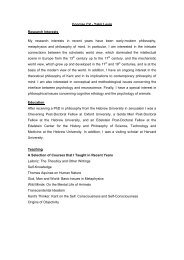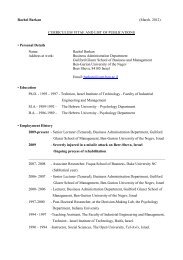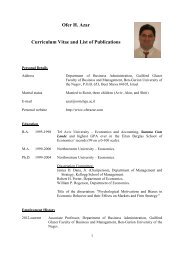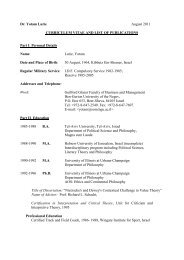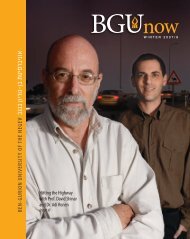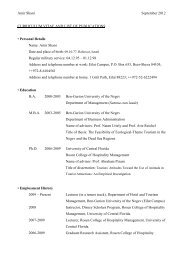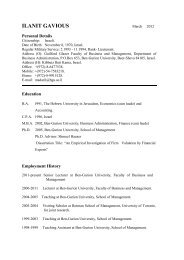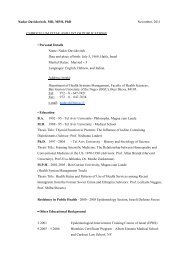Book of Abstracts
Book of Abstracts
Book of Abstracts
You also want an ePaper? Increase the reach of your titles
YUMPU automatically turns print PDFs into web optimized ePapers that Google loves.
Architecture and city planning in dry areas: A case study <strong>of</strong> the Pink city <strong>of</strong> India<br />
32<br />
Shailendra Mandal and Kamini Sinha; Department <strong>of</strong> Architecture; National Institute <strong>of</strong> Technology, Patna, India;<br />
vastumandala@yahoo.com<br />
Jaipur which is also referred to as the Pink City <strong>of</strong> India is noted for its architectural wonder. The architecture <strong>of</strong> this<br />
capital city <strong>of</strong> Rajasthan is a beautiful fusion <strong>of</strong> yesteryears and modern architecture. Jaipur is the first planned city<br />
<strong>of</strong> India, located in the drylands <strong>of</strong> Rajasthan. Jaipur was planned as a grid system with wide straight avenues, roads,<br />
streets and lanes and uniform rows <strong>of</strong> shops on either side <strong>of</strong> the main roads, all arranged in nine rectangular city<br />
sectors (chokdis), representing the ancient Hindu map <strong>of</strong> the universe.<br />
The renaissance approach <strong>of</strong> the 18 th century walled city <strong>of</strong> Jaipur is reflected not only in its exclusive and<br />
innovative architecture and city planning but also in the conception <strong>of</strong> the city as a thriving trade and commerce hub<br />
in the dry region <strong>of</strong> the country. These two significant factors guiding the planning <strong>of</strong> Jaipur has provided a unique<br />
urban identity and continuity to the 21 st century capital. Historically, Jaipur became a commendable example <strong>of</strong><br />
architecture and city planning visited by many domestic and international travelers from the 18 th till the 20 th century.<br />
The post independence Jaipur developed and extended as a modern city yet retained the living, historic core as the<br />
image <strong>of</strong> the city. However, the recent trends in global architecture and economic pressures within the walled city<br />
have lead to an increasing transformation <strong>of</strong> the urban fabric, observed in the construction <strong>of</strong> unauthorized, multistoried<br />
commercial complexes that are fast replacing some <strong>of</strong> the beautiful havellies in the inner residential areas <strong>of</strong><br />
the region. There is an urgent need to arrest this process as well as to readdress the present situation in lieu <strong>of</strong> the<br />
recent architecture and city planning reform initiatives and the new invasion <strong>of</strong> global tourism. It is equally crucial<br />
to evaluate the traditional architecture and city planning principles <strong>of</strong> the city and the extent <strong>of</strong> their applicability in<br />
the present context.<br />
The proposed paper presents the similarities and contrasts between the 18 th century vision <strong>of</strong> the city, the perceptions<br />
<strong>of</strong> historic visitors to the city, the urban form, streets, spaces and usage vis a vis the ‘21 st century Heritage Vision’ <strong>of</strong><br />
Jaipur, as it is a very apt example <strong>of</strong> the architecture and city planning in the dry region <strong>of</strong> the country. The<br />
fundamental contention <strong>of</strong> this paper is that architecture and city planning play a key role in strengthening adaptive<br />
capacities. It evaluates the present circumstances, the socio- economic situation, the residents’ aspirations, the<br />
linkages to their pasts and their expression, and translation and interpretation in the global environment. It also<br />
presents the conflicting approaches to heritage fabric and its usage by the residents, NGOs and the local government<br />
departments. It concludes with the question - whether an integrated, holistic approach through the proposed Heritage<br />
Plan can again showcase Jaipur as the 21 st century Renaissance city which stands as an appropriate example <strong>of</strong> great<br />
architecture and city planning in dry areas.<br />
The services <strong>of</strong> cultural heritage in drylands: An approach from water traditional technologies as a<br />
territory heritage system <strong>of</strong> desert<br />
Gabriela Pastor - gpastor@mendoza-conicet.gob.ar; Dra. Laura Torres - ltorres@mendoza-conicet.gob.ar;<br />
Argentine Institute <strong>of</strong> Dryland Research – CONICET; Mendoza, Argentina<br />
The concept <strong>of</strong> heritage no longer suffices to define and identify the hallmarks <strong>of</strong> identity upon which the territory is<br />
built. The definitions and declarations expressed within the framework <strong>of</strong> international organizations can barely<br />
point out the “photograph” <strong>of</strong> some elements in which the hallmarks <strong>of</strong> identity attested to by these testimonies are<br />
overlooked or invisible. On the other hand, traditional technologies are a heritage system that exceeds the<br />
testimonial object, while simultaneously containing it, to integrate not only people and environmental resources but<br />
territory as well.<br />
This communication aims at characterizing the social, economic, political, and landscape services that traditional<br />
technologies, in their character as territory heritage systems, are capable <strong>of</strong> assuming, whilst allowing for a<br />
discussion not only on the notions and concepts <strong>of</strong> heritage but also on its standing in the field <strong>of</strong> more sustainable<br />
development. To this end, a case study linked to strategies for access to water in drylands <strong>of</strong> the Argentinean west is<br />
undertaken. The starting point is assuming that these strategies articulate traditional knowledge and landscapes that<br />
provide an account <strong>of</strong> processes, resources and positioning which transcend the material and immaterial facts <strong>of</strong><br />
heritage to synergize the same restrictions but in favour <strong>of</strong> the territory. Material testimony and associated<br />
knowledge are analyzed, as well as their implications to the provision <strong>of</strong> services that aid in building the territory



